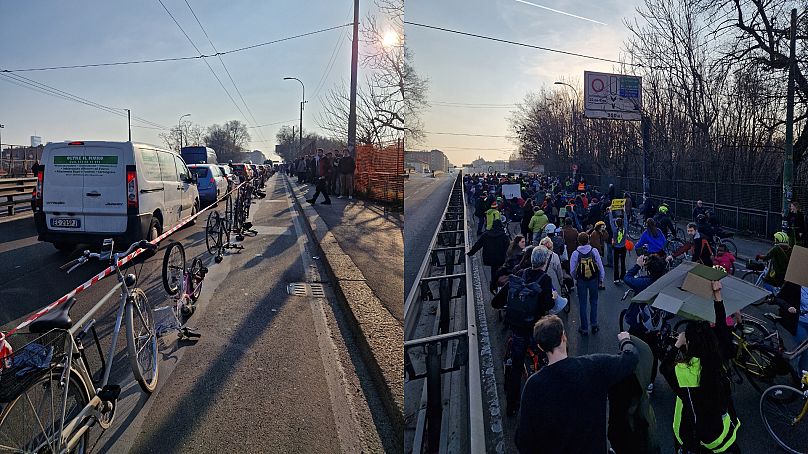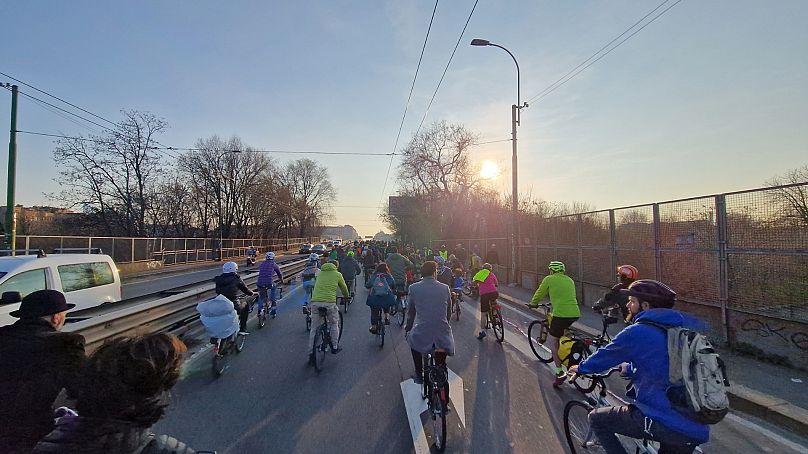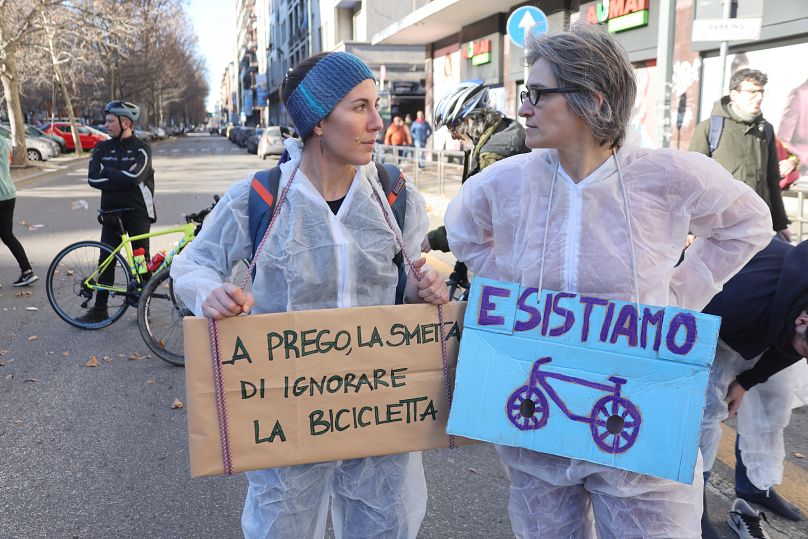Through demonstrations and urban proposals, cycle activists are paving the way for a safer, less polluted and bike-friendly Milan.
Riding a bike on a sunny summer afternoon, Davide Branca arrives at a café next to Ponte della Ghisolfa in Milan, a two carriageways bridge where cars run past at high speed.
It has become a symbol of the fight of Milan’s cycling community which has been waiting for a bike lane since 2018.
The city has a long history of bike activism. Branca himself is a member of Massamarmocchi, a grassroots project which sees adults bring kids to school every morning in bike convoys.
But despite an increase in public transport and cycleways, the financial capital of Italy, known for its culture of speed and work, is often clogged up by traffic. It is the fifth most congested city in the world, the annual TomTom traffic index shows.
At the café, the noise from high-speed cars on the Ponte della Ghisolfa resonates. Leaning on a pole nearby is Ilaria Lenzi’s bike, her helmet placed on the handlebars.
She is a bike activist and campaigner for Clean Cities Campaign - a European coalition promoting zero-emission mobility in cities by 2030.
Sitting in the shade, Lenzi lists the typical dangers she faces while cycling: “Speed, little awareness from cars driving past very close, lack of visibility when cars are ‘wildly parked’ or lack of continuity of the bike lanes network.”
All it takes is a ride around the city to spot cars double parked, left on the sidewalks or blocking bike lanes with cyclists forced to dangerously slalom outside. It is a frustrating reality for Branca who moves around the city only by bike.
Cyclists take to the streets to protest in Milan
Italy has one of the highest motorisation rates in Europe. Research of the Clean Cities campaign shows that the government invests almost 100 times more in cars than in cycling.
Cities have an average of 2.8 km of cycleways for every 10,000 people. In Milan, the ratio is 2.1 km, lagging behind other major European cities like Ghent (20.2), Helsinki (19.8), Strasbourg (7.0) or Brussels (3.1).
New research from Politecnico of Milan led by Paolo Bozzuto - the “Atlas of the dead and badly injured cyclists in Italy” - shows cycling accidents are increasing in the city too.
But only 24.1 per cent of all bike accidents involve individual cyclists, while 48.77 per cent happen with cars. This rises to 68 per cent if also crashes with motorbikes and heavy transports are considered.
Milan-based cyclists, worried about what they call a safety emergency, have started protesting. Organised under the mobilisation campaign ‘Sai che puoi’, activists are urging the municipality to improve urban planning for a car-free future.
The movement has grown following numerous deaths of cyclists over the last few months, four of them just this year in collisions with heavy vehicles.
“Vulnerable users - pedestrians, cyclists, two-wheelers, including motorised vehicles - are most exposed to danger,” says Luca Studer, professor of Traffic and Road Safety at Milan Politecnico.
If we want sustainable mobility, we must protect these users, Studer points out.
“Cyclists are a strong community in Milan,” Branca says. Last November, 400 people stood along the bike lane in Viale Monza, one of the most used cycleways in the city.
Holding placards and lining up their bikes they formed a human barrier to protect cyclists from cars.
Then, they occupied the Ponte della Ghisolfa, creating the much awaited bike lane with their bodies and bikes.
The events spearheaded others in the city, with almost 1,500 people lying down with their bikes in Piazzale Loreto square after another cyclist was killed, and sparked dozens of similar demonstrations all over Italy.
Last week, a woman was killed by a cement mixer while cycling, sparking another protest in Piazzale Loreto.
The activists of ‘Sai che puoi’ have outlined a series of proposals for the municipality to take urgent measures and update citizens on their implementation.
They include a well-connected bike lanes network, constant monitoring of motorisation rate and pollution, car-free school streets, urban interventions supporting sustainable mobility, and 30km/h speed limits.
A 30km/h city: Safety and space for people
In January, Milan’s administration talked about introducing 30km/h speed limits. The activists claim it’s a political move which hasn’t been effective so far and are pushing for a real implementation of the measure through investments.
Milan wouldn’t be an isolated case. In 2021, Brussels slowed car speeds down to 30km/h, leaving only some major roads at 50km/h. The first results showed success, with a decrease in accidents and noise pollution, contradicting those who feared traffic would have increased.
The measure would also help the European Union’s goal of reducing road deaths to zero by 2050.
Speed limits of 30km/h would temper sudden acceleration and abrupt slowdowns, a pattern of city driving.
“During the rush hours, there are ‘speed hiccups’: cars go very fast and then they stop, and collisions increase”, Branca says, shaking his head. Despite an increase in people cycling in the city after the pandemic, he believes fear discourages many more from getting on their bikes.
“Having an accident with a car at 50 km/h means falling from the third floor, having it at 30 km/h means falling from the first,” Studer explains.
“Driving slower, you see what is going on around you. A car driving at 30km/h stops in less than half of the space.”
For Studer, 30km/h speed limits won’t be successful with just traffic signs and fines. It requires urban geometry interventions - wider sidewalks, trees, chicanes, bollards - and changes in attitudes from drivers that must become aware of the presence of cyclists. A cultural change that rewards slow mobility is needed too.
Overall, the idea is to veer towards an overhaul of the city space, making room for people.
Cutting down on cars to open up public space
The number of cars in Milan makes the coexistence between vehicles and vulnerable users complicated.
Data collected by “Sai che puoi” estimates that there are 297,000 regular on-street parking spaces and another 100,000 irregular ones. If in Milan there are 22 parking spaces for every 100 inhabitants - the figure is only seven for Barcelona and six for Paris.
“Cyclists are more exposed to imagine a different city because we see space differently,” says Lenzi.
An example of what fewer cars could mean is the European-wide “School Street” initiative of the Clean Cities Campaign. It closes roads around schools to traffic, prioritising walking and cycling - at least at school pick-up times - through tactical urbanism.
Working with other parents, Lenzi opened a car-free street at her kids’ school, with great success among the children.
What used to be a street with dozens of parking spots is now a colourful pedestrian area where kids play after school.
For the activists, a car-free city is also a change in habits which eventually will lead not only to less pollution and noise, but a safer and more sustainable city.
“The idea is redesigning the city for people,” Lenzi says as she leaves the café and jumps on her bike for her daily school run.














